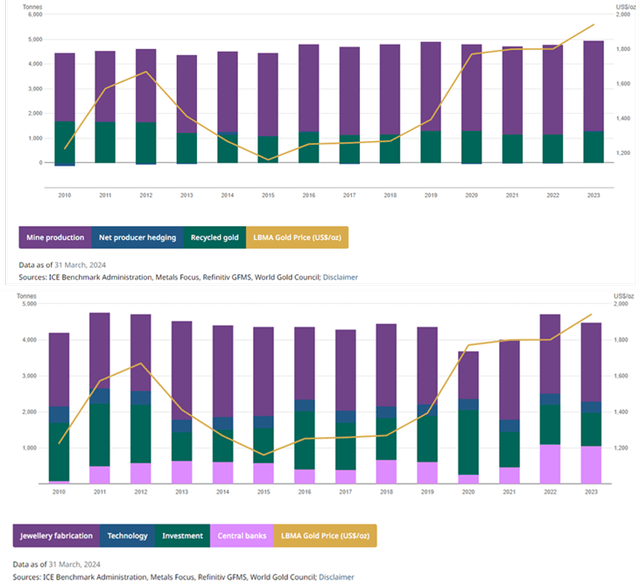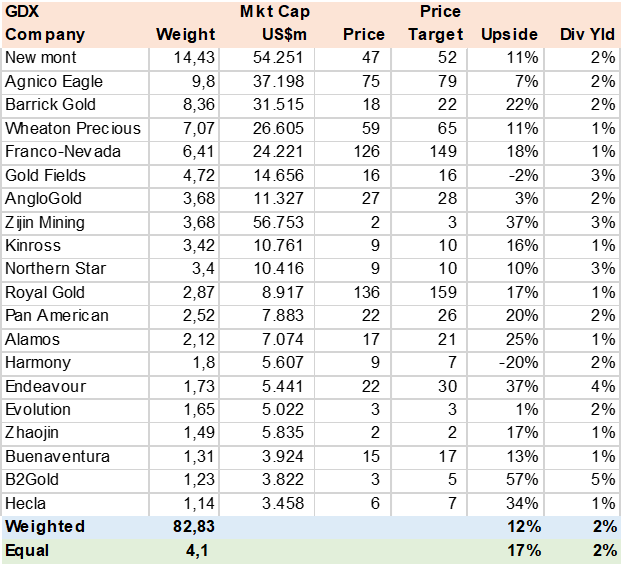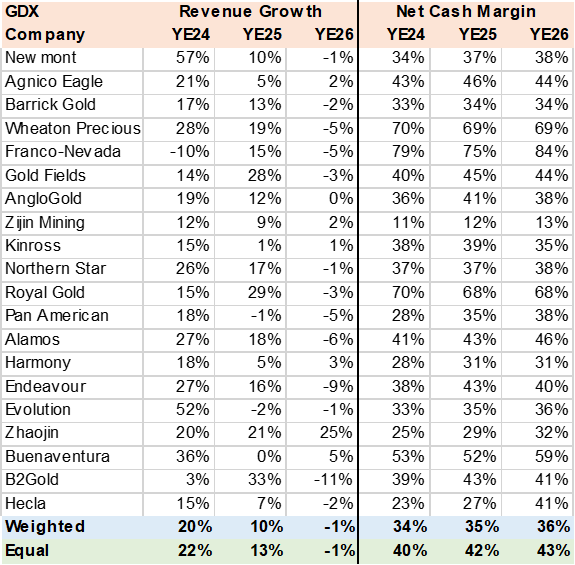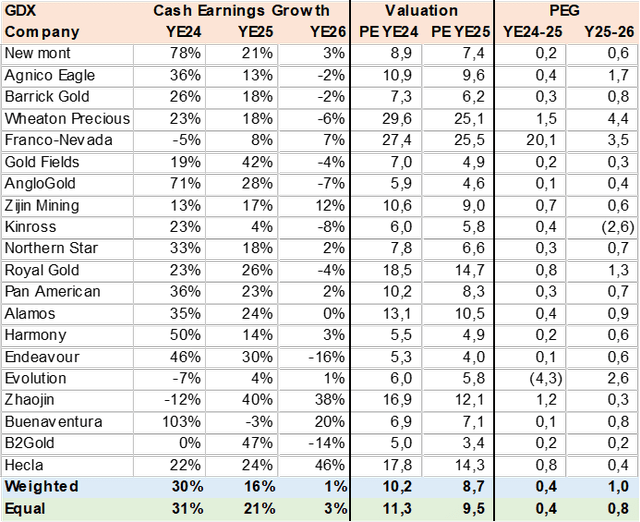Introduction
Last week I analyzed a junior gold miner called Aura Minerals (OTCQX:ORAAF) (ORA:CA) that has exceptional growth due to capacity expansion with the obvious execution risks that piqued my interest in other mining companies. While I am not enamored with Gold as a store of value, the market believes it has defensive properties and may be a good hedge against runaway US government spending and increasing fiscal deficits, and thus I looked into the VanEck Gold Miners ETF (NYSEARCA:GDX) to better understand if mining companies are a better investment than the underlying precious metal.
Performance
I compared GDX to the gold price, several gold mining ETFs, and a few of the larger holdings to get a sense of how GDX performs vs the underlying assets. The outcome is less than great, with gold surprisingly less volatile and beating most ETFs and miners in the last 10 years and since GDX´s inception. Note that the ETF and stock prices include dividends for a total return comparison.
It seems that a portfolio of gold mining stocks, whether large cap or juniors, does not outperform the price of gold. However, a few stocks do, which require an active investing approach that many may shun away from.
GDX Performance (Created by author with data from Capital IQ)
Gold Demand & Supply Balance
Gold is a useless metal, it has almost zero industrial application and modest consumer demand in the form of jewelry. The primary demand for gold is as a “store of value” or hedge vs inflation and currency devaluation. It’s an abstract concept that society has deemed true and assigns a value to it very similar to crypto “currencies”, the price of gold depends almost exclusively on the perception of value. I am not in favor of nor against this store of value concept, but rather accept it and attempt to understand the price drivers and how to better invest in gold.
The supply of gold has been at under 5,000 tons while demand has oscillated between 4,000 and 4,800 tons since 2010 with central bank and investment demand providing the swing factor. At the same time, gold prices are volatile with a wide trading range from US$800oz to the current high of US$2500oz. The future demand is most likely driven by the perception of a store of value in the face of currency weakness, inflation, and higher fiscal deficits.
World Gold Council
Portfolio Upside
The GDX is a concentrated portfolio with the top 5 stocks equal to 46% of AUM, the fund shies away from small or junior miners in this ETF. I gathered consensus price target estimates for 82% of AUM and calculated a weighted upside potential of 12% plus a 2% dividend yield to YE24. These price targets are normally driven by the estimated volume growth and cost structure of a company, and generally do not incorporate higher gold prices.
Consensus Price Target (Created by author with data from Capital IQ)
Revenue Growth & Margins
The consensus estimates that the portfolio may have 20% revenue growth in 2024 followed by a 10% increase in 2025 but then a decline in 2026. These high revenue growth estimates are most likely driven by the sharp increase in the price of gold, up 17% YTD, and have a carryover effect into 2025. What is odd is a decline in 2026 that may be attributed to a lack of operating visibility.
Consensus Revenue Growth (Created by author with data from Capital IQ)
Valuation
The mining sector generally is assigned a low valuation due to the uncertainty of commodity prices, while operating costs are largely fixed, and mining is highly capital intensive. This creates a boom-and-bust cycle that investors attempt to smooth out with discounted valuations. The consensus valuation for the YE24-25 period is a 0.4x PEG that rises to 1.0x in the YE25-26 period as earnings growth falters. As mentioned earlier, due to the unpredictability of gold prices, estimates more than two years out become very difficult to predict, and thus the market assumes stagnation.
Consensus Valuation (Created by author with data from Capital IQ)
Risk
The risks to GDX can be split into two. The price of gold is volatile and has had wild price swings not only due to supply/demand balances but also due to investor sentiment given gold’s store of value trait. The second factor, reduced through diversification, is driven by individual company operations, reserve life, and expansion execution. A drop in gold prices will likely have a negative but varying impact on the valuation of each mining company.
Conclusion
I rate GDX a sell. It appears that a portfolio of gold mining stocks does not consistently outperform the underlying gold price. Investors may be better served to buy gold (ETF or Futures) or select one or two mining companies with high reserves, capacity growth, and low extraction costs.
Read the full article here








